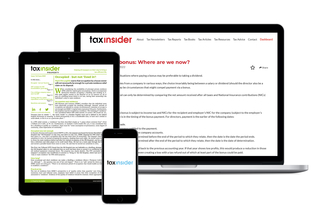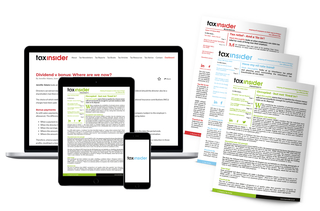New articles published
in December 2025
-
Using AI for HMRC Disputes? Think Again
Artificial intelligence (AI) apps like ChatGPT and Copilot have become very popular in recent years. AI apps are versatile, and can help with a wide range of tasks, from writing reports to language translation.
Mark McLaughlin warns of potential dangers for taxpayers of using AI when dealing with disputes with HM Revenue and Customs.
-
MTD for ITSA: Big Changes Coming in 2026
A significant development will reshape the way small businesses in the UK manage their tax affairs from 6 April 2026. VAT-registered businesses are already using Making Tax Digital (MTD) for VAT reporting, which was introduced in 2019; but MTD for income tax self-assessment (MTD for ITSA) is a major change to the reporting and recording of business income.
While the aim is to streamline tax collection and improve accuracy, small business owners must be prepared for a range of new obligations and potential pitfalls.
Richard Curtis highlights the major changes in small business accounts reporting that start in April 2026.
-
When HMRC Gives Wrong Advice: What Are Your Rights?
HMRC once had a generous policy on misdirection – although it was not necessarily generously applied! In Notice 48 (March 2002) Extra-Statutory Concessions, it stated:
‘If a Customs & Excise officer, with the full facts before him, has given a clear and unequivocal ruling on VAT in writing or, knowing the full facts, has misled a registered person to his detriment, any assessment of VAT due will be based on the correct ruling from the date the error was brought to the registered person’s attention.’Andrew Needham looks at what happens when HMRC gives a business incorrect advice or a ruling.
-
Partnership Appeals: What the Nominated Partner Controls
The ‘nominated partner’ of a partnership is responsible for:
• filing the partnership tax return;
• dealing with matters arising from an enquiry; and
• keeping the other partners informed of the progress of any enquiry.
Crucially (for the other partners), any appeal rights relating to the partnership are conferred only on the nominated partner.Kevin Read examines the appeal rights within partnerships.
-
Tax on Death: The Rules You Might Not Know
As well as being the two certainties in life, death and taxes often go hand in hand. This article highlights how they interact in certain instances.
Tristan Noyes explores some of the lesser-known tax rules applicable on death.
-
Excess Company Cash: What Should You Do With It?
Whilst having a large bank balance represents financial security and flexibility, leaving significant sums of cash sitting idle in the company’s bank account (i.e., more than a contingency or 'rainy day fund', or more than needed for expansion or investment) is not always the best long-term strategy.
Jennifer Adams looks at some options to consider if companies have more cash in their bank accounts than is needed for their day-to-day operations or future needs.
-
Is Incorporation Worth It? The Hidden Dangers
Many small businesses will start out as sole traders – the owner and the business are one and the same. Personal and business assets are kept apart only by a set of accounts and a balance sheet; and for tax purposes, the sole trader is taxed on the profit, not withdrawals. In effect, they are the business.
Risks inherent within that business, or the high burdens of income tax (or both), may lead to ‘incorporation’ (i.e., transferring the business into a limited company); but is incorporation worth it?Chris Thorpe outlines some potential dangers inherent in incorporating a business.
-
Q&As with Arthur Weller
Some of our most popular articles
-
Dividends or bonuses? We can work it out!
Consider the following scenario:
'On a wintry sunny morning, Alan was reviewing his company’s January 2024 management accounts. Alan was the sole director and 100% shareholder of Llandudno Hotels Ltd, which operated two large hotels in Llandudno. The business was on course to healthy pre-tax profit of around £650,000 for the year ended 31 March 2024. Alan had been planning to pay himself a substantial ‘bonus’ before the year-end'.
What does Alan do?
Peter Rayney examines an owner-manager’s cash extraction following the numerous tax and National Insurance contributions changes.
-
Use them or lose them: 2023/24 tax allowances
As the tax year draws to a close, it is prudent to review one’s 2023/24 tax allowances and consider whether there is scope for utilising any unused allowances so they are not lost.
Sarah Bradford explores options for using 2023/24 tax allowances so they are not wasted.
-
Record-keeping in a digital age
Lee Sharpe looks at taxpayers’ record-keeping obligations in light of HMRC’s inexorable march to digital everything (almost).
Historically, HMRC has been quite relaxed about whether original records must be maintained or digital facsimiles (scans, etc.).
-
Trap for business owners seeking CGT incorporation relief
HM Revenue and Customs (HMRC) recently commenced a ‘One to Many’ campaign, targeting taxpayers who incorporated property businesses in the tax year 2017/18 but reported no capital gains tax (CGT) liability in their tax returns on the basis that ‘incorporation relief’ applied in full.
Mark McLaughlin highlights a potential trap for business owners seeking capital gains tax incorporation relief.
-
Q&As with Arthur Weller
Subscription Benefits
We asked our subscribers what they love about Tax Insider Bundle.
These are the top 7 reasons that they gave us:
Monthly Newsletter
Tax Insider Bundle…





